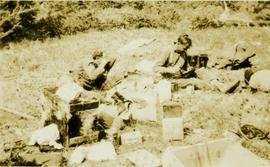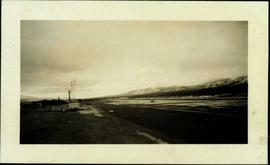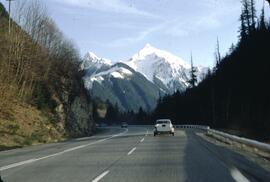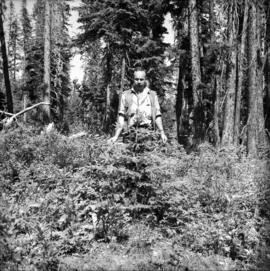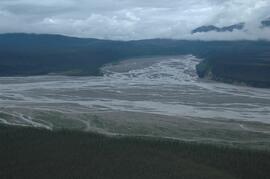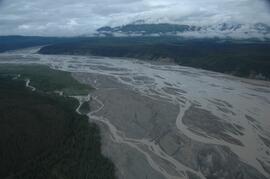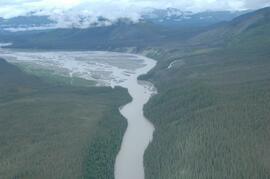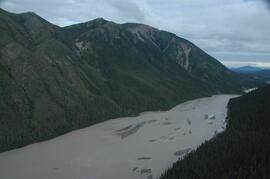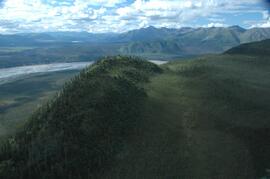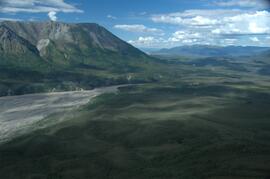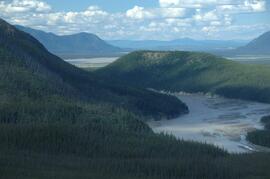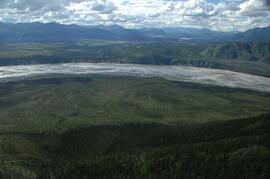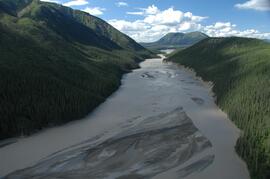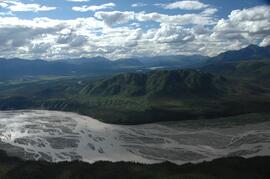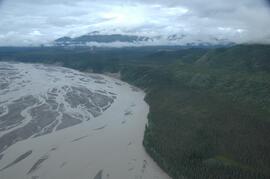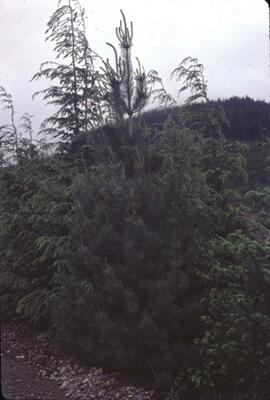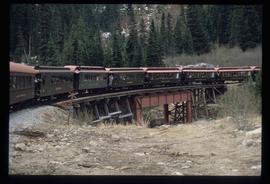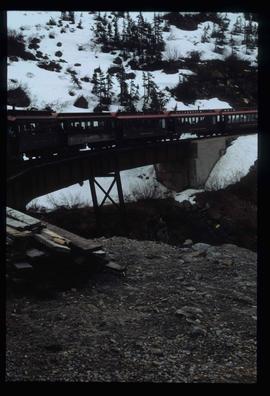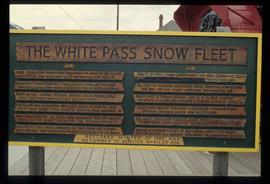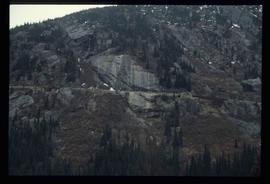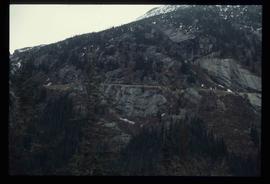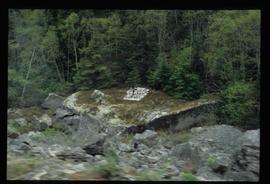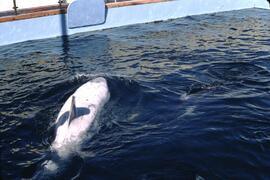Item is a photograph of two survey crewmen seated on the ground surrounded by camp rations and eating.
File contains correspondence to Brian Fawcett from Whitney Smith. Includes letters to Brian Fawcett from Whitney Smith of the Society For The Conservation Of Wild Culture. Letters predominately written 1986 to 1988.
Aerial view, Alpine Club of Canada's 1967 Yukon Alpine Centennial Expedition, Kluane National Park, Yukon
Handwritten photo album caption below this photo reads: "Whitehorse 'Runway'". Photograph depicts three planes in distance on runway, one of them is parked in front of large building on left (hangar?). Two long unidentified buildings in background on left, trees and range of hills in background on right. See also items 2006.20.12.1 & 2006.20.12.43.
Royal Canadian Air ForcePhotograph depicts a group of Whitehorse citizens watching a military parade in front of a Canadian Bank of Commerce.
Aerial view, Alpine Club of Canada's 1967 Yukon Alpine Centennial Expedition, Kluane National Park, Yukon
File consists of printed and photocopied research materials concerning Jean White-Haney's life and work in Australia.
File contains correspondence to Brian Fawcett from Whitecap Books Ltd.. Includes a letter to Brian Fawcett from Colleen MacMillan, Publisher of Whitecap Books Ltd., regarding his deadline for reviews on gardening titles. Letter dated April 18, 1991.
File consists of biographical information and research materials about Australian anthropologist, Isobel White.
File consists of "Take Paradise" by Don White.
Frontal detail of <i>Pedicularis</i> in flower, Nunavut
Caption describing photograph: "White Spruce within 20' of pine (see GBW Film 3 Frame 1 - 2007.1.30.2.026). Same age, same site. Height 5' 1966 leader 6". Adelges." Harry Coates stands in the photograph for scale.
Footage of white robin.
Location of filming is unknown.
This image is part of the outbound sequence of aerial images obtained on the helicopter flight to the Klutlan Glacier study site. The sequence starts from the base camp at the White River crossing on the Alaska Highway and heads south, to a point just upvalley of the debris-covered terminus (approx. 10-15 km from Alaska border), and turning back north to the landing spot on the Generc River floodplain close to the study site (see Fig. 1 in paper).
This image is part of the outbound sequence of aerial images obtained on the helicopter flight to the Klutlan Glacier study site. The sequence starts from the base camp at the White River crossing on the Alaska Highway and heads south, to a point just upvalley of the debris-covered terminus (approx. 10-15 km from Alaska border), and turning back north to the landing spot on the Generc River floodplain close to the study site (see Fig. 1 in paper).
This image is part of the outbound sequence of aerial images obtained on the helicopter flight to the Klutlan Glacier study site. The sequence starts from the base camp at the White River crossing on the Alaska Highway and heads south, to a point just upvalley of the debris-covered terminus (approx. 10-15 km from Alaska border), and turning back north to the landing spot on the Generc River floodplain close to the study site (see Fig. 1 in paper).
This image is part of the outbound sequence of aerial images obtained on the helicopter flight to the Klutlan Glacier study site. The sequence starts from the base camp at the White River crossing on the Alaska Highway and heads south, to a point just upvalley of the debris-covered terminus (approx. 10-15 km from Alaska border), and turning back north to the landing spot on the Generc River floodplain close to the study site (see Fig. 1 in paper).
This image is part of the outbound sequence of aerial images obtained on the helicopter flight to the Klutlan Glacier study site. The sequence starts from the base camp at the White River crossing on the Alaska Highway and heads south, to a point just upvalley of the debris-covered terminus (approx. 10-15 km from Alaska border), and turning back north to the landing spot on the Generc River floodplain close to the study site (see Fig. 1 in paper).
This image is part of the return trip sequence of aerial images obtained on the helicopter flight leaving the Klutlan Glacier study site. On the return leg at the end of the day, the flight initially went upvalley to pick up another party. This image was taken after the helicopter turned north to return to base camp.
This image is part of the return trip sequence of aerial images obtained on the helicopter flight leaving the Klutlan Glacier study site. On the return leg at the end of the day, the flight initially went upvalley to pick up another party. This image was taken after the helicopter turned north to return to base camp.
This image is part of the return trip sequence of aerial images obtained on the helicopter flight leaving the Klutlan Glacier study site. On the return leg at the end of the day, the flight initially went upvalley to pick up another party. This image was taken after the helicopter turned north to return to base camp.
This image is part of the return trip sequence of aerial images obtained on the helicopter flight leaving the Klutlan Glacier study site. On the return leg at the end of the day, the flight initially went upvalley to pick up another party. This image was taken after the helicopter turned north to return to base camp.
This image is part of the return trip sequence of aerial images obtained on the helicopter flight leaving the Klutlan Glacier study site. On the return leg at the end of the day, the flight initially went upvalley to pick up another party. This image was taken after the helicopter turned north to return to base camp.
This image is part of the return trip sequence of aerial images obtained on the helicopter flight leaving the Klutlan Glacier study site. On the return leg at the end of the day, the flight initially went upvalley to pick up another party. This image was taken after the helicopter turned north to return to base camp.
This image is part of the outbound sequence of aerial images obtained on the helicopter flight to the Klutlan Glacier study site. The sequence starts from the base camp at the White River crossing on the Alaska Highway and heads south, to a point just upvalley of the debris-covered terminus (approx. 10-15 km from Alaska border), and turning back north to the landing spot on the Generc River floodplain close to the study site (see Fig. 1 in paper).
File consists of issues of the literary periodical entitled "White Pelican", including volume 1 issue 1 through volume 4 issue 1 (incomplete).
Alpine Club of Canada's 1967 Yukon Alpine Centennial Expedition, Kluane National Park, Yukon
Image depicts the White Pass Train crossing over a railway bridge at an uncertain location.
Image depicts the White Pass Train crossing over a railway bridge at an uncertain location in the mountains.
Image depicts the White Pass Train crossing over a railway bridge at an uncertain location.
File contains slides depicting locations along the White Pass railway through Alaska, British Columbia, and the Yukon Territories.
Image depicts a sign, labelled "The White Pass Snow Fleet," which details the history of the fleet; it is located in Skagway, Alaska.
Item is a White Pass & Yukon Route pamphlet from 1971. Shows illustrated route map and fares.
File consists of a promotional publication entitled "White Pass & Yukon Route: A Pictorial Journey".
Series consists of material regarding the White Pass and Yukon Route, a narrow gauge railway that links Skagway and Whitehorse. Includes monographs about the history of the railway.
File consists of research material regarding the White Pass & Yukon Railway. Predominantly consists of photocopy reproductions, excerpts from books, and clippings from periodicals. Includes the following works: "A Trip on the White Pass & Yukon Route - 1994" by Lacey; "White Pass' New Gold" by Zimmerman; "Taku Tramway, 1900 to 1937: BC's Shortest 'Short Line' Railway at 2.3 Miles" by Davies; "The White Pass & Yukon Route" by MacBride; "America's Only Modern Narrow Gauge: White Pass & Yukon has Revamped Everything But Its Gauge" by Morgan; "Canada's Newest Steam Operation" by Meldrum; "The WP&YR's Lewis Lake Disaster: an 1899 Engineering Blunder" by Johnson; "Gold Rush Line" by Bruce West; "The Amazing White Pass - Part Two: Riding the Mixed to Whitehorse and Back" by D'Amanto; "White Pass & Yukon Route and the Ton of Gold Special"; "The 'New' White Pass & Yukon Route: Will It Be Standard-Gauged?" by Johnson; "White Pass Storms to New Passenger Records" by Johnson; "White Pass Centennial: One Hundred Years and Getting Better" by Nicklason; "WY&PR's Yukon Adventure Train Reaches Carcross" by Johnson and Cooper; and "When the US Army Took Over the White Pass" by Douglas N.W. Smith.
Image depicts a mountain side somewhere along the White Pass railway. The thin ridge along the mountain side is possibly either a highway or part of the railway.
Image depicts a mountain side somewhere along the White Pass railway. The thin ridge along the mountain side is possibly either a highway or part of the railway.
Image depicts a grave somewhere along the White Pass railway.
File consists of a memorandum to Campagnolo regarding a green paper on fitness and recreation, and a white paper on sport. Also includes a draft containing the objectives for the white paper on sport, a report by Campagnolo on the future of sports in Canada, a draft plan concerning sport and recreation entitled "A National Plan for Sport," and notes.
A blueprint produced by Strong Lamb and Nelson (Kamloops) LTD. It shows the plan the roof framing and sections.
A blueprint produced by Strong Lamb and Nelson (Kamloops) LTD. It shows the site plan of a building.
A blueprint produced by Strong Lamb and Nelson (Kamloops) LTD. It shows the plan the foundation plan and sections.
A blueprint produced by Strong Lamb and Nelson (Kamloops) LTD. It shows the general notes and typical details of a building.
A blueprint produced by Strong Lamb and Nelson (Kamloops) LTD. It shows the plan for first floor and front elevation of a building.
